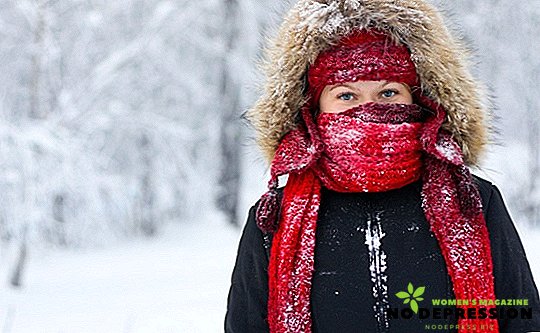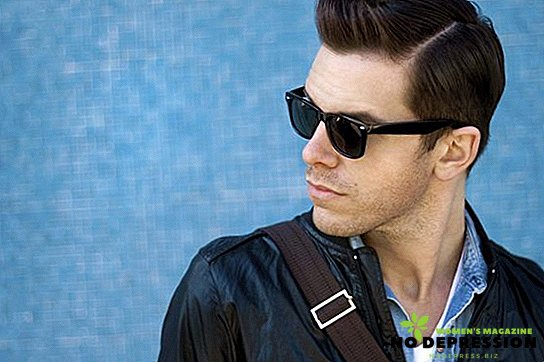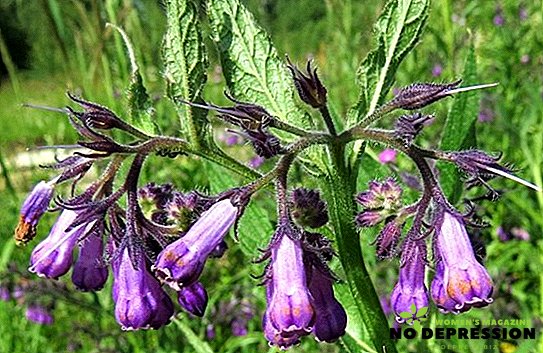Allergic processes in the body can trigger not only familiar allergens, but also temperature changes, such as cold. This is a rather unpleasant phenomenon, which causes a lot of inconvenience, especially in the winter season.
How to deal with this pathology, what symptoms should pay attention to? All of this you will learn from today's material.

Causes of
In the case of a cold allergy, the main irritant is low air temperature, usually below zero.
The subzero temperature causes a large amount of histamine to be released into the body, which causes such side effects as itching, redness of the skin, puffiness, chills, headaches and so on.
The following factors may contribute to skin allergies:
- long-term medication, usually antibiotics;
- chronic diseases, including: sinusitis, tonsillitis, sinusitis, cervical caries;
- the presence of worms in the body;
- problems with the digestive tract, kidney and liver disease;
- dysbacteriosis;
- malfunctions in the endocrine system;
- stress;
- colds;
- oncology.
If allergic symptoms appear on the face or hands, these warning signals should not be ignored. At the first symptoms, you should immediately consult a doctor.
It is also worth knowing that allergies can not only manifest themselves in the frosty air, sometimes the allergens are banal drafts, washing dishes in cold water, swimming in the pool, and so on.
Symptoms
When a person enters a warm room with frosty air, the face, ears, hands and neck become red. Everything is logical, this is the usual reaction of the body to a temperature drop, as a result of which the blood vessels expand and the blood flow increases. However, usually redness passes within 15-40 minutes. But allergic reactions to the cold do not pass so quickly and are more active.
On the skin of the hands
 Disturbing symptoms of "cold allergy" on the hands can be:
Disturbing symptoms of "cold allergy" on the hands can be:
- pink or red spots on the hands, which become inflamed with time;
- in the cold, hands begin to itch and itch, itching does not pass for a long time;
- watery blisters form on the skin of the hands;
- swelling of hands;
- when a person entered from a frost into a warm room, moderate or intense swelling of fingers and hands is observed;
- microcracks may appear on the skin, from which the blood or rye oozes.
If the skin begins to crack, then this alarming symptom simply cannot be ignored. The fact is that by contacting the palms of the hands with various surfaces, an infection can enter the body through microcracks, including dangerous viruses that are transmitted by contact.
You can conduct a simple experiment that will show whether the cold is an allergen. It is necessary to attach an ice cube to the back of the hand, if there is no redness and rash after this action, it means that there is no allergy.
On the face
 Unfortunately, the face is an open area of skin that cannot be protected during frosts. If you are allergic to cold, it is often on your face that such unpleasant symptoms appear as:
Unfortunately, the face is an open area of skin that cannot be protected during frosts. If you are allergic to cold, it is often on your face that such unpleasant symptoms appear as:
- vulgar pustules;
- papules;
- peeling of the skin;
- microcracks;
- unbearable itching.
In order to somehow protect the skin of the face in the cold, it is necessary to smear it with greasy creams.
Other
"Cold allergy" can manifest itself not only by a rash and redness on the hands and face, other symptoms may also indicate this pathology. In addition to the obvious visible manifestations of the cold, the following body reactions may occur:
- labored breathing;
- intense headaches;
- runny nose;
- choking cough;
- constant sore throat;
- tearing;
- sneezing
The fact is that each organism is individual and responds to external stimuli in different ways, including allergens. If one person has a “cold allergy” in the form of a rash, then another person’s main reaction is tearing and sneezing.
Cold allergy treatment
To prevent the unpleasant consequences that self-treatment can cause, the first thing is to contact an experienced doctor for qualified help. Only after a series of clinical and laboratory studies can determine the nature and cause of the disease. The doctor will prescribe a comprehensive treatment that will eliminate the symptoms of allergies.
In adult
If the allergy manifests itself in adults, and the rash in the frosty air is permanent, then it is wiser to take the following actions:
- If you feel a strong cold, the first thing you need to warm up. To do this, you can go to the nearest premises, such as a cafe.
- If skin rashes have already appeared as a reaction to cold, you can lubricate the affected skin with any antihistamine ointment. This will help not only to remove redness and swelling, but also to eliminate itching.
- If mucous membrane reacts to cold air, you can use nasal or eye antihistamine drops before going outside.
- If the manifestation of allergies is permanent, then you will have to use antihistamines in the form of syrups or tablets.
All of the above activities are aimed only at the removal of common symptoms. To approach this problem more globally, without the advice of experienced professionals simply can not do.
Only a doctor can prescribe complex therapy with the use of drugs that will eliminate the true cause of allergic reactions.
The child has
The whole difficulty of diagnosing "cold allergy" lies in the fact that this pathology is similar in its symptoms to atopic dermatitis. What treatment can a doctor determine for a child who is allergic to frosty air?

- Symptomatic treatment. The use of antihistamine drugs external and internal action. Before going out in the winter, it is recommended to put a child's nose with antihistamine drops.
- Reduce the effect of cold air. It is possible to protect the skin of the child as much as possible from contact with cold. To do this, you can use fatty creams, warm gloves and the most closed cap. It is best to use a thermal jacket with a hood.
- Use of children's creams for wind and frost. There is a mass of various drugs of external action that will help protect your child from the negative effects of cold. It is very important that the cream is fat, safe and does not contain harmful substances. The composition of such creams include: natural minerals, vitamin complexes, paraffin, wax, fish oil, and more. These funds are absolutely safe for health and not addictive. The cream is applied 25 minutes before going outside. In addition, you can also lubricate your lips with special hygienic lipstick.
- The use of sorbents and probiotics. If a child has taken antibiotics for a long period of time, he has dysbacteriosis and is allergic to cold, then most often the doctor advises to cleanse the body, using sorbents for these purposes. Also in this case, it is recommended to use probiotics.
- Hardening Hardening of the body plays a very important role. Thanks to this, you can get rid of allergies to cold air. Hardening should be carried out gradually, adhering to the general recommendations of the doctor in this matter.
Disease prevention
If you, fortunately, do not know what “cold allergy” is, then it’s time to take preventive measures that will prevent this unpleasant pathology from occurring.
Preventive measures are simple and clear, it is not difficult to observe them. The first thing you need to follow as a rule is to dress warmly in the cold season. You can not neglect the headgear or gloves. Also useful is to use before going out to the street creams from the cold air.
Wash dishes need only in warm water. In no case should not allow hypothermia hands. If the "cold allergy" has already manifested itself, in this case, the stay in the frosty air should be reduced to a minimum.
Well, having familiarized yourself with the first signs of a cold allergy, you will probably use our advice and consult a doctor for qualified help. Preventive measures will help prevent unpleasant pathology at the initial stage.












